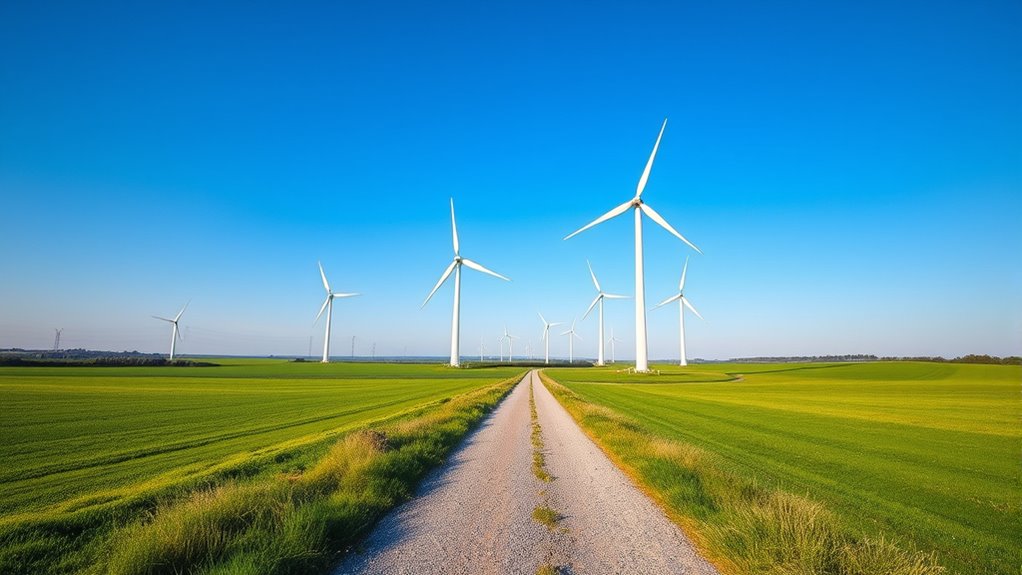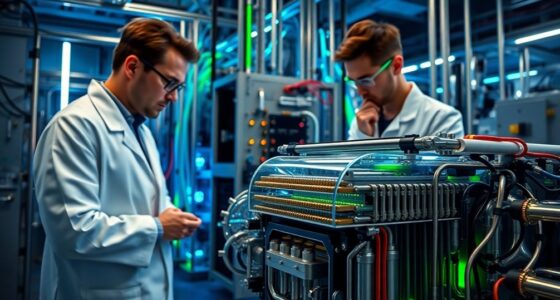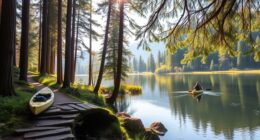Wind energy is a clean, renewable source that uses turbines to convert the motion of air into electricity. When wind flows over blades, it creates lift, turning turbines and generating power. Larger blades and taller turbines capture more wind, increasing efficiency. Proper site selection, considering wind patterns and environment, helps maximize output. If you want to understand how these turbines work and improve energy in your community, keep exploring how wind power transforms our world.
Key Takeaways
- Wind energy converts the kinetic energy of moving air into electricity using turbines.
- Turbines have blades shaped to maximize lift and minimize drag, increasing efficiency.
- Proper site selection considers wind patterns, geography, and proximity to infrastructure for optimal performance.
- Taller turbines and longer blades capture more wind at higher altitudes, boosting energy output.
- Advances in technology, including AI and new materials, improve turbine efficiency, reduce costs, and ensure sustainability.

Ever wondered how wind can power your home or city? It all starts with understanding the basics of wind energy and how it transforms into electricity. At the heart of this process are turbines, which are specially designed to capture the wind’s kinetic energy. The turbine design is essential because it determines how efficiently the wind is converted into usable power. Modern turbines feature blades shaped to maximize lift and reduce drag, allowing them to generate more energy even in low wind speeds. The size and placement of these blades also matter; larger blades can catch more wind, making the turbines more productive. When planning a wind farm, engineers and developers carefully analyze wind patterns, local geography, and environmental factors to guarantee the turbines are positioned for maximum efficiency and minimal impact. Wind farm planning involves evaluating wind resource maps, which indicate how much wind blows through different areas throughout the year. By selecting the best locations, they ensure that the turbines operate at high capacity factors, producing consistent electricity. This planning process also considers the proximity to power lines and existing infrastructure to reduce transmission costs.
Once the site is chosen, the design of the turbines becomes even more vital. Engineers work to enhance turbine height, blade length, and overall layout to balance energy output with costs and environmental considerations. Taller turbines with longer blades can access higher wind speeds at greater altitudes, boosting energy production. The placement of turbines within the wind farm is also strategic, often arranged in rows aligned with prevailing wind directions to prevent turbulence and wake effects that diminish efficiency. During wind farm planning, they also evaluate local wildlife and community concerns to minimize disruptions and obtain necessary permits. It’s a complex process that combines technical expertise with environmental awareness. Additionally, ongoing research in AI innovations contributes to optimizing turbine performance and predictive maintenance, further enhancing wind energy efficiency.
Throughout the planning and design stages, ongoing research helps improve turbine technology, making wind energy more affordable and reliable. Innovations in blade materials, gearboxes, and control systems allow turbines to operate efficiently across a broader range of wind conditions. As you learn about wind energy, it’s clear that turbine design and wind farm planning are interconnected steps that determine how effectively wind is harnessed. When these elements are optimized, they help make wind power a sustainable, clean, and cost-effective energy source. So, the next time you see a wind farm, remember the careful planning and engineering behind those spinning turbines that turn the breeze into electricity, powering your world with clean energy.
Frequently Asked Questions
How Do Wind Turbines Withstand Extreme Weather Conditions?
You should know that wind turbines are built for storm resilience and blade durability. Engineers design blades with strong materials to withstand extreme weather, including hurricanes and heavy snow. Turbines are equipped with sensors that detect high winds, automatically shutting down to prevent damage. This combination of durable blades and smart systems guarantees your wind turbines remain operational and resilient during severe weather, protecting your investment and maintaining energy production.
What Are the Common Environmental Impacts of Wind Farms?
Think of wind farms as modern-day giants, but they can impact the environment too. You might notice bird migration disruptions or hear noise pollution from the turbines. While they reduce greenhouse gases, they sometimes pose risks to bird populations and create noise issues for nearby communities. Balancing clean energy with ecological health is key, and ongoing research helps mitigate these impacts for a more sustainable future.
How Does Wind Energy Compare Cost-Wise to Other Renewable Sources?
You’ll find that wind energy generally has a favorable cost comparison to other renewables like solar and hydro, especially over the long term. Its economic viability improves as technology advances, reducing installation and maintenance costs. While initial investments can be high, wind power often offers competitive energy prices, making it a cost-effective choice. Overall, wind energy stands out as a sustainable, economically viable option in the renewable energy landscape.
What Are the Latest Technological Advancements in Wind Turbine Design?
You’ll find that recent advancements in wind turbine design focus on aerodynamic blades, which increase efficiency by capturing more wind energy. Additionally, smart sensors play a vital role, allowing you to monitor turbine performance in real-time and predict maintenance needs. These innovations help you optimize energy output, reduce downtime, and lower costs, making wind power more competitive and reliable in today’s renewable energy landscape.
How Can Individuals Participate in or Benefit From Wind Energy Projects?
You can participate in wind energy projects through community investment, where your funds help develop local wind farms, earning you profits and supporting green initiatives. Additionally, consider a personal installation by installing small-scale turbines on your property, reducing your energy bills and carbon footprint. The opportunity to benefit from wind energy is closer than you think—seize it now, and be part of the clean energy revolution that’s shaping the future!
Conclusion
Now that you understand how wind energy works, you see it as both a powerful resource and a fragile one. While it can generate clean electricity, it depends on nature’s unpredictable breath. This contrast reminds you that harnessing wind requires respect for its force and variability. Embracing wind energy means balancing innovation with patience, knowing that in this dance with nature, strength and humility go hand in hand.










